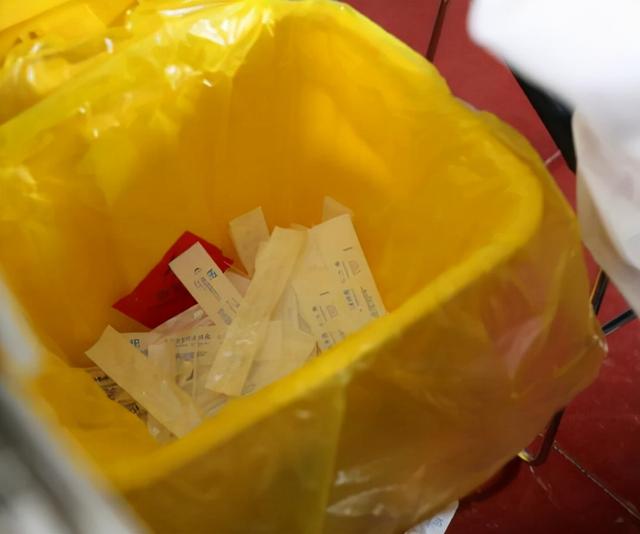Em hospitais, cotonetes são uma ferramenta crítica para coleção de amostras, controle de infecção, e testes de diagnóstico. No entanto, a gestão de resíduos de esfregaços é uma questão complexa que as instalações de saúde devem abordar para garantir a sustentabilidade ambiental e a segurança do paciente. O descarte de cotonetes e outros resíduos médicos é regulamentado por diretrizes rígidas para minimizar a contaminação e prevenir a propagação de infecções. Aqui está uma visão geral de como os hospitais gerenciam resíduos de swab:

A importância do descarte adequado de swab
Cotonetes, incluindo swabs de algodão, cotonetes de espuma, e swabs reunidos, são usados em uma ampla gama de procedimentos médicos. Após o uso, Eles geralmente estão contaminados com fluidos corporais, patógenos, ou produtos químicos. O descarte inadequado de resíduos de swab pode levar à contaminação cruzada, a disseminação de infecções, e riscos ambientais. Os hospitais devem aderir às diretrizes estabelecidas pelas autoridades de saúde e agências de proteção ambiental para garantir um manuseio seguro, disposição, e reciclagem desses materiais.
Etapa 1: Categorizando o desperdício médico
Um dos primeiros passos que os hospitais tomam para o gerenciamento de resíduos de swab é classificar os resíduos corretamente. Os resíduos de swab se enquadram na categoria de “Resíduos médicos regulamentados” (Rmw) Devido ao seu potencial de infecção. Os resíduos médicos geralmente são classificados nas seguintes categorias:
- Desperdício infeccioso: Isso inclui swabs que foram usados para coleta de amostras ou cuidados com feridas e estão contaminados com fluidos ou patógenos corporais.
- Aparecedores de desperdício: Embora os próprios swabs não sejam nítidos, Eles podem ser contaminados com agulhas ou outros objetos nítidos e são descartados de acordo.
- Resíduos não infecciosos: Alguns swabs podem estar contaminados com substâncias não infecciosos e são categorizados como não perigosos.
Categorizando o desperdício corretamente, Os hospitais garantem que cada tipo de desperdício seja descartado da maneira apropriada.
Etapa 2: Descarte e segregação seguros
Uma vez que o desperdício de swab é coletado, é segregado em código de cores, Recipientes à prova de vazamentos que cumprem os requisitos regulatórios locais para resíduos médicos. Na maioria dos hospitais, Um sistema de segregação de resíduos de três camadas é usado:
- Lixeiras vermelhas: Para desperdício infeccioso, como swabs usados em testes para vírus ou infecções bacterianas.
- Caixas amarelas: Para resíduos médicos gerais que podem não ser infecciosos, mas ainda precisam ser tratados com cuidado.
- Recipientes nítidos: Para agulhas usadas e objetos nítidos que possam estar em contato com swabs.
Cada recipiente de resíduos é fortemente selado para evitar vazamentos e minimizar o risco de infecção. Os hospitais também fazem uso de especializado, Sacos de biohazard para conter swabs usados e outros resíduos antes de serem transportados para as áreas de descarte.
Etapa 3: Métodos de tratamento e descarte
Os resíduos de swab são tipicamente esterilizados e tratados para garantir que esteja livre de qualquer agente infeccioso. Os dois principais métodos para o tratamento de resíduos médicos são:
- Autoclave: O método mais comum para tratar resíduos infecciosos, Autoclave usa vapor sob pressão para esterilizar o lixo. O calor alto garante que quaisquer patógenos nos swabs sejam destruídos antes de serem enviados para o descarte final.
- Incineração: Em alguns casos, Os resíduos médicos são incinerados em altas temperaturas para garantir a destruição completa de microorganismos nocivos. Este método é particularmente eficaz para resíduos que não podem ser autoclavados.
Após a esterilização, O resíduo tratado é enviado para um aterro sanitário ou instalação de reciclagem, dependendo da natureza do lixo. Os hospitais estão cada vez mais adotando práticas ambientalmente amigáveis, como reduzir a quantidade de resíduos não recicláveis que eles geram, e alguns swabs podem ser reciclados após a esterilização.
Etapa 4: Reciclagem e sustentabilidade
Nos últimos anos, Muitos hospitais se voltaram para práticas mais sustentáveis de gerenciamento de resíduos, incluindo reciclagem e reprocessamento de determinados itens médicos. Embora a reciclagem dos próprios swabs possa não ser possível devido à contaminação, Alguns materiais associados ao desperdício de swab, como embalagem e componentes plásticos, pode ser reciclado. Os hospitais estão investindo em tecnologias de desperdício em energia e opções de descarte sustentável para reduzir seu impacto ambiental.
Adicionalmente, Fabricantes médicos estão produzindo swabs e outros consumíveis feitos de materiais biodegradáveis ou ecológicos para mitigar a quantidade de resíduos não recicláveis gerados. Os hospitais também podem reduzir sua pegada ambiental otimizando o gerenciamento de inventário e reduzindo o uso desnecessário de swabs de uso único.
Etapa 5: Treinamento e conformidade da equipe
O gerenciamento eficaz de resíduos começa com a equipe de saúde bem treinada. Os hospitais fornecem treinamento para todo o pessoal envolvido no manuseio e descarte de resíduos médicos, garantir que eles entendam a importância dos protocolos de segurança e a segregação de resíduos adequados. Os hospitais também estão em conformidade com o local, estado, e regulamentos nacionais para minimizar o risco de exposição a doenças infecciosas e contaminação ambiental.
Conclusão
Os hospitais devem gerenciar cuidadosamente os resíduos de swab para proteger a saúde pública e o meio ambiente. Seguindo protocolos rigorosos para categorizar, descartando de, e tratamento de resíduos médicos, As instalações de saúde minimizam os riscos associados ao descarte de swab. À medida que os hospitais continuam a adotar a sustentabilidade, As práticas de gerenciamento de resíduos evoluirão para atender às necessidades de saúde e objetivos ambientais.

















